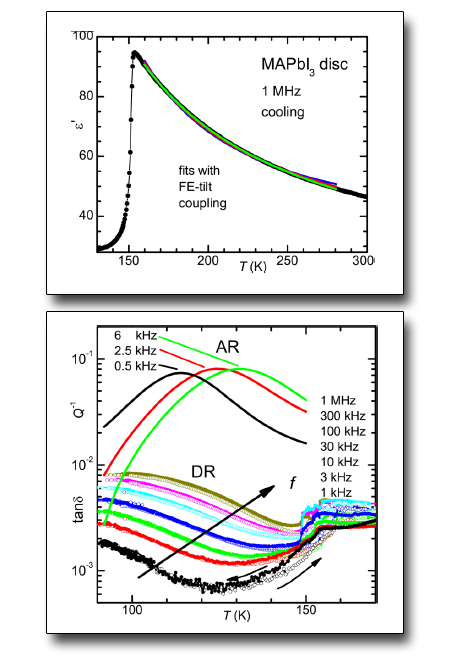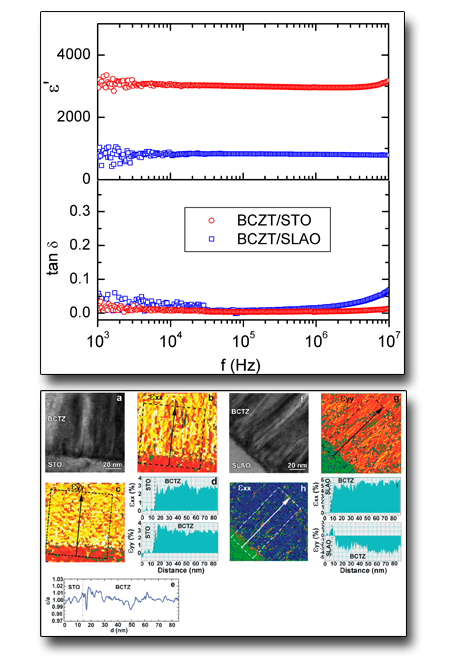Research Activity
Dielectric spectroscopy measures the response of electrical polarization of a medium to an applied electrical field. It is used for the characterization of polar materials (ferroelectrics, relaxor ferroelectrics, multiferroics, photovoltaics, organic-inorganic halide perovskites, electrochemical systems, energy storage capacitor elements) and multiple phase systems (polymer-ceramics composites). In the latter heterogeneous materials dielectric spectroscopy usually reveals a universal dielectric response, characterized by a power law relationship between the electrical impedance and the frequency of the applied electric field. Dielectric spectroscopy (or impedance spectroscopy) is used also for microstructural characterization, dielectric characterization of biological media, fuel cell testing etc. It is possible to study all dipolar defects and excitations, the mobility of atoms (diffusion, trapping, defect reorientation, tunneling, cooperative motion etc.), polarons, free charges, and ferroelectric phase transitions and domain wall movements.
- Ferroelectric/antiferroelectric materials
- Relaxor materials
- Organic-inorganic halide perovskites
- Piezoelectric/polymer composites
- Heterogeneous dielectric materials
- Thin films and heterostructures

As an example of thin film heterostructures characterization by dielectric spectroscopy, it has been shown that (Ba,Ca)(Zr,Ti)O3 (BCZT) thin films grown on different substrates show very different dielectric properties. Lead-free BCZT thin films show high dielectric permittivity and piezoelectric properties, which make them very appealing for energy harvesting applications. Dielectric spectroscopy measurements evidenced a huge increase of dielectric permittivity with respect to bulk (and films grown on SLAO substrates) for thin films grown epitaxially on SrTiO3 substrates. This has been correlated with results from HRTEM and geometrical phase (GPA) analysis which show that the origin of the increased dielectric permittivity resides in the appearance of nanoscale domains as a result of epitaxial strain relaxation.

Instrumentation
Collaborations
- Scientific collaboration and participation to common projects with Francesco Cordero CNR-ISM (Tor Vergata) for anelastic measurements.
- Scientific collaboration and participation to common projects with the group of Carmen Galassi, CNR-ISTEC (Faenza) for the preparation of ferroelectric ceramic samples.
- Scientific collaboration and participation to common projects with con Annamaria Paoletti, Gloria Zanotti, Giovanna Pennesi, CNR-ISM (Montelibretti) for preparation of samples of organic-inorganic perovskites for photovoltaic and ferroelectric applications.
- Scientific collaboration and participation to common projects with the group of Maria Dinescu, National Institute for Laser, Plasma and Radiation Physics, Bucharest, Romania for preparation and characterization of ferroelectric and multiferroic thin films.
- Scientific collaboration and participation to common projects with the group of Victor Fruth, Institute of Physical Chemistry, Romanian Academy, Bucharest, Romania, for the preparation and characterization of organic-inorganic ferroelectric materials.
- Scientific collaboration and participation to common projects with the group of Mirjana Vijatovic, Institute for Multidisciplinary Research, Belgrade, Serbia, for the preparation and characterization of composite polymer-ceramic ferroelectric and multiferroic flexible fillms.

 English (UK)
English (UK)  Italiano (Italia)
Italiano (Italia)